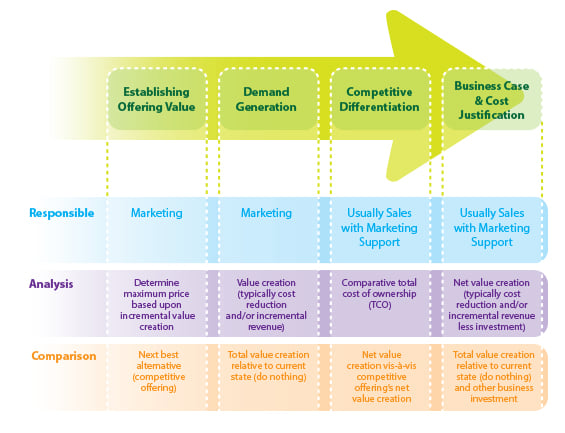This is Part I of a five-part series about the life-cycle of value in B2B selling and marketing. Part I is an introduction and a summary four phases of the value life-cycle.
Whether you’re in sales or marketing, it is obviously in your best interest to understand what value you offer to customers. What most sellers and marketers don’t realize is that value has different meanings depending on where you are in the marketing/sales cycle. The “value life-cycle” has four distinct phases (listed below) – as you’ll see, different phases require input from different roles in the company.

Phase 1: Establish Offering Value (and price)
Initially, a marketing/development team defines value and sets price for a new offering. The common mistake here is that marketers set the price based on what the competition is charging or, worse yet, based on their own cost – not based on the value they create relative to the competition. During Phase 1 you will always be measuring value against the customer’s next best alternative (often a competitive offering).
Phase 2: Demand Generation
At this phase, marketing aims to project to the customer a picture of how your value can help them relative to what they’re doing today. At this point in the value life-cycle, you are trying to “shine a flashlight” on how much the problems that you can solve are really costing them. During Phase 2 you are measuring value against their current state.
Phase 3: Competitive Differentiation
At this point, sales (with support from marketing) needs to show the customer why their offering provides more value and is a better fit than competitive offerings. In Phase 3 you are showing that the total value your creates – throughout the life-cycle of the solution – is higher than the total value created by the next-best alternative (aka, a competitor). This is often referred to as TCO, or Total Cost of Ownership.
Phase 4: Business Case & Cost Justification
By Phase 4, the sales team is actively trying to close a deal. A cost-justified business case is key to convince a financially minded approver (often a CFO or someone from finance) that an investment in your solution is in their economic best interest. During Phase 4 you are showing the Net Present Value (NPV) and Return on Investment (ROI) of investing in your solution (as we’ve written before, this is why it’s important to understand financial terms and communicate intelligently with CFOs). This type of analysis compares their current state of cash flow against what their cash flow will be after they invest in your solution.
How you think about value should change based on which phase you’re in. Phase 1 is strategic marketing, and the meaning of value is very different from Phase 4, during which sales is talking with the customer. The way you think about value at each phase will have an enormous influence on your ability to successfully position your product in the market and keep deals moving through the pipeline until they end in a successful sale.
While most people in sales and marketing do think (and talk) a lot about value, they don’t necessarily think about it within this framework. We’ll explore each of these phases more in four upcoming blog posts.
A final note: the word “value” is always about dollars and cents in the B2B world. If you can’t lower the cost of doing business for your customer and/or find a way to help them increase revenue, you’re not offering value and customers shouldn’t buy from you.
How do you think about value for your offerings? Do you have tools that help you to show value across the various stages of the value life-cycle?















